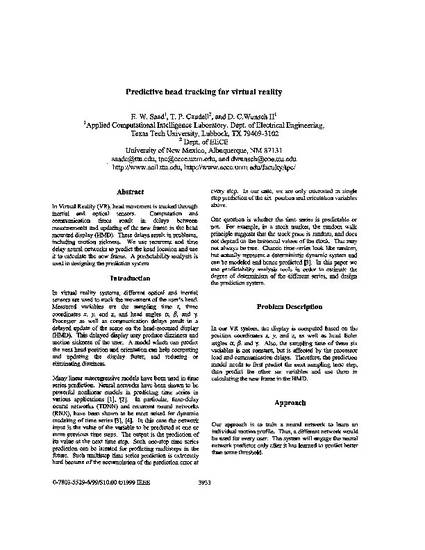
Article
Predictive Head Tracking for Virtual Reality
Proceedings of the International Joint Conference on Neural Networks, 1999. IJCNN '99
Abstract
In virtual reality (VR), head movement is tracked through inertial and optical sensors. Computation and communication times result in delays between measurements and updating of the new frame in the head mounted display(HMD). These delays result in problems, including motion sickness. We use recurrent and time delay neural networks to predict the head location and use it to calculate the new frame. A predictability analysis is used in designing the prediction system
Meeting Name
International Joint Conference on Neural Networks, 1999. IJCNN '99
Department(s)
Electrical and Computer Engineering
Keywords and Phrases
- HMD,
- VR,
- Head Mounted Display,
- Head Movement Tracking,
- Helmet Mounted Displays,
- Inertial Sensors,
- Motion Sickness,
- Optical Sensors,
- Predictability Analysis,
- Predictive Head Tracking,
- Recurrent Neural Nets,
- Recurrent Neural Networks,
- Time Delay Neural Networks,
- Tracking,
- Virtual Reality
Document Type
Article - Conference proceedings
Document Version
Final Version
File Type
text
Language(s)
English
Rights
© 1999 Institute of Electrical and Electronics Engineers (IEEE), All rights reserved.
Publication Date
1-1-1999
Publication Date
01 Jan 1999
Disciplines
Citation Information
Donald C. Wunsch, Emad W. Saad and T. P. Caudell. "Predictive Head Tracking for Virtual Reality" Proceedings of the International Joint Conference on Neural Networks, 1999. IJCNN '99 (1999) Available at: http://works.bepress.com/donald-wunsch/312/
